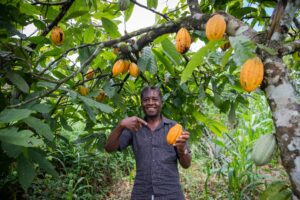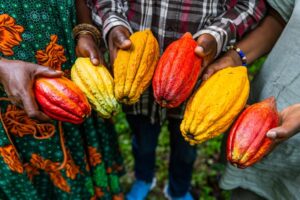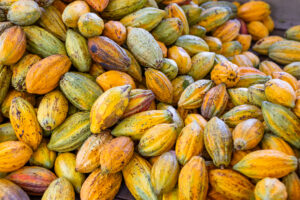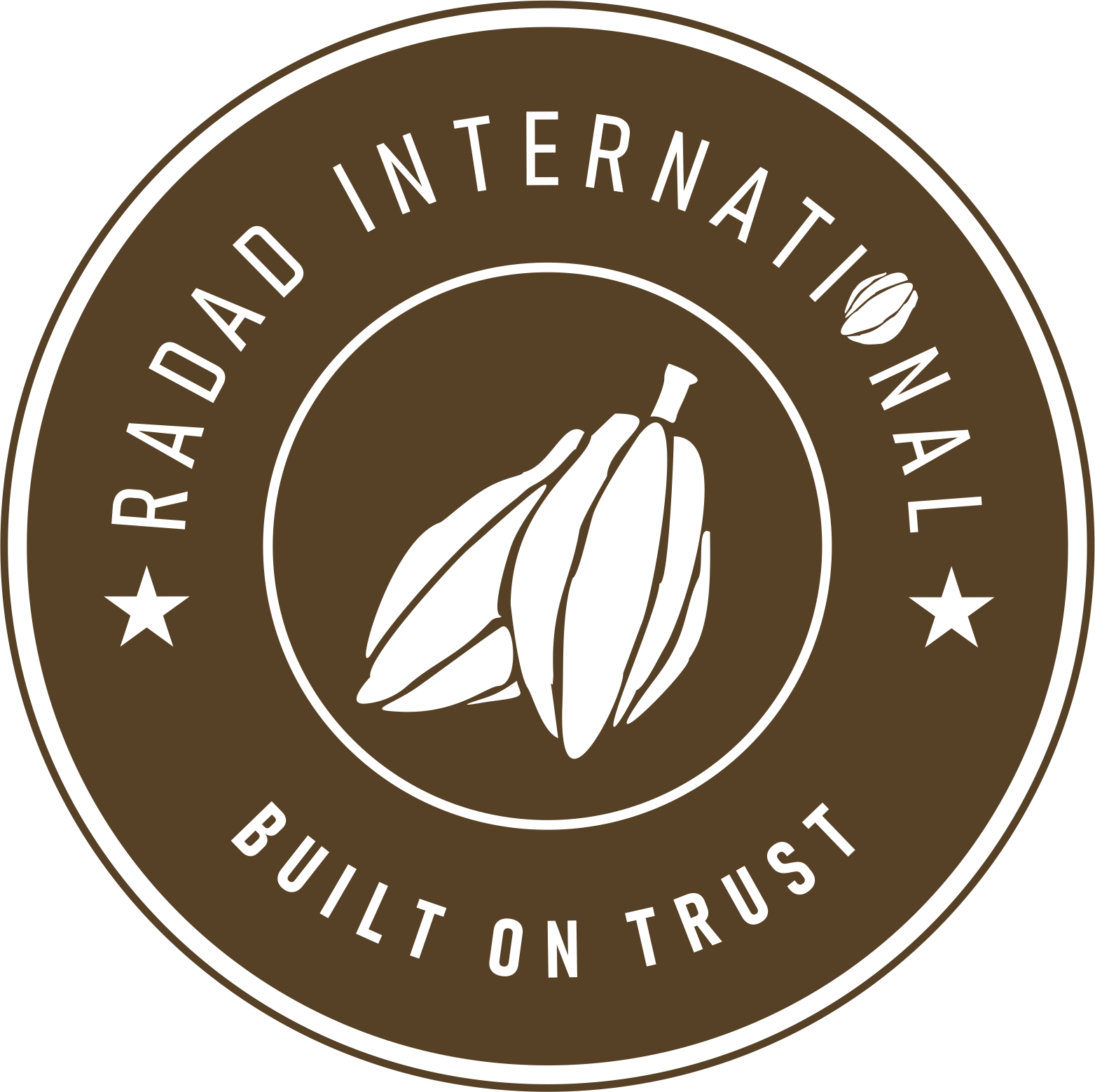When we talk about chocolate or cocoa-based products, the conversation often revolves around origin, ethical sourcing, or percentage of cocoa solids. But rarely do we pause to examine a much deeper layer of the cocoa story—the type of cocoa bean used. And yet, for farmers, exporters, manufacturers, and brand owners, the variety of cocoa is one of the most important choices influencing flavour, processing behaviour, cost, and ultimately, consumer satisfaction.
There are more than 10 known genetic groups of cocoa, but most of the global cocoa trade is dominated by just three: Forastero, Criollo, and Trinitario. These three form the commercial backbone of the chocolate industry and differ significantly in flavour profile, disease resistance, yields, and ideal usage.
Understanding the distinctions between these cocoa bean types is no longer just a concern for craft chocolatiers or specialty importers—it’s a strategic knowledge area for:
-
- Bulk manufacturers seeking consistency
-
- Premium brands seeking story and origin
-
- Cosmetic and nutraceutical companies sourcing cocoa butter and antioxidants
-
- Sustainable buyers seeking long-term supply partnerships with farmers
This is because the type of cocoa bean you choose has a direct impact on everything from product flavour and shelf life to cost structure, branding potential, and customer loyalty.
An Overview of the Main Cocoa Varieties (Forastero, Criollo, Trinitario)
Cocoa Isn’t One Thing—It’s a Spectrum. Cocoa is a complex agricultural product. Like coffee or wine, its characteristics vary dramatically based on botanical variety, soil composition, climate, post-harvest handling, and even local fermentation traditions. Two batches of beans harvested from the same genetic stock can produce entirely different flavour profiles if one is grown in Venezuela and the other in Côte d’Ivoire.
And this is where manufacturers often miss the point: Not all cocoa beans are created equal. A bulk-processing factory looking to supply compound chocolate for biscuit coating has a very different requirement than a bean-to-bar craft chocolatier targeting the high-end European market. The beauty of the cocoa ecosystem lies in its diversity—and its success lies in knowing how to work with it.
1. Forastero – The Global Standard
-
- Makes up about 80–85% of global cocoa production.
-
- Known for its strong, bold cocoa flavour, high yields, and durability.
-
- Grown widely in West Africa, especially Côte d’Ivoire, Ghana, Nigeria, and Cameroon.
-
- Commonly used in mass-market chocolates, cocoa powder, and industrial processing.
2. Criollo – The Noble Cocoa
-
- Represents less than 5% of world cocoa.
-
- Offers a delicate, nuanced flavour with notes of fruit, nuts, and floral tones.
-
- Grown in select regions like Venezuela, Peru, Nicaragua, and Madagascar.
-
- Valued for premium chocolate and fine-flavour cocoa products.
-
- Rare, fragile, and more expensive to cultivate.
3. Trinitario – The Hybrid with Balance
-
- A hybrid of Criollo and Forastero, originally developed in Trinidad.
-
- Combines flavour complexity with better disease resistance and yield.
-
- Grown in Latin America, the Caribbean, Papua New Guinea, and parts of Southeast Asia.
-
- Often used in mid- to high-end chocolate products and specialty food brands.
Why Manufacturers Should Care About Cocoa Types
Key reasons to care about cocoa variety:
-
🧠 Flavour Differentiation: Criollo adds complexity; Forastero adds strength.
-
💸 Cost Efficiency: Forastero offers scalability; Trinitario offers balance.
-
🏷️ Brand Storytelling: Single-origin or heirloom Criollo can justify premium pricing.
-
♻️ Sustainability Alignment: Knowing your variety helps align with ethical sourcing models and traceability.
-
🧪 Processing Behavior: Cocoa bean type affects fermentation, roasting profile, and even tempering performance in final chocolate production.
Criollo Cocoa – The Ancestral Bean of Fine Flavour Chocolate
History and Genetic Identity of Criollo Cocoa
-
Porcelana – A pale-seeded Criollo from Venezuela, often called the “white cocoa” for its colour and delicate taste.
-
Chuao – A Criollo variant grown in a remote valley in Venezuela, often sold as single-estate beans.
| Feature | Criollo Cocoa |
| Global Share | Less than 5% |
| Primary Regions | Venezuela, Peru, Nicaragua, Madagascar |
| Flavour | Complex, mild, floral, fruity |
| Yield | Low |
| Disease Resistance | Low |
| Best For | Premium chocolate, cocoa nibs, gourmet applications |
| Price Point | High |
🌱 Where Criollo Is Grown Today
-
Venezuela – Especially Aragua, Chuao, and Zulia regions.
-
Peru – Notably in the Cusco and Piura regions.
-
Nicaragua – Where conservation programs are preserving old Criollo lines.
-
Mexico – Especially Chiapas and Tabasco, where Criollo has historical roots.
-
Madagascar – Often a blend of Criollo and Trinitario, known for fruit-forward notes.
Flavour Profile and Sensory Characteristics
Typical flavour notes include:
-
Dried fruits: raisin, fig, cherry
-
Floral tones: jasmine, rose, orange blossom
-
Nutty layers: almond, cashew, hazelnut
-
Spices: cinnamon, vanilla, clove
-
Sweet finishes: honey, toffee, mild caramel
⚠️ Challenges for Farmers and Buyers
❌ Low Yields
❌ Disease Susceptibility
❌ Inconsistent Supply
Use Cases for Criollo – Where It Truly Belongs
Ideal applications include:
-
Single-origin and estate chocolate bars
-
Fine couverture for gourmet pastry chefs
-
Premium drinking chocolate and ceremonial cacao
-
High-end cocoa nib snacks
-
Artisan confectionery and truffles
-
Craft liqueurs or cocktail bitters
-
Cosmetic-grade Criollo butter for natural beauty brands
📈 Market Relevance and Commercial Positioning
-
Justify premium pricing through origin and scarcity.
-
Tap into connoisseur and luxury markets.
-
Develop educational product stories around bean lineage and terroir.
-
Align with slow food, ethical trade, and heirloom preservation movements.
-
Build long-term relationships with origin partners.
-
Embrace seasonal variability.
-
Support transparent supply chains to ensure traceability.
Criollo Hybrids
Forastero Cocoa – The Backbone of the Global Cocoa Industry
Where Is Forastero Grown?
Major producing countries include:
-
Ivory Coast (Côte d’Ivoire)—The world’s top cocoa producer, accounting for over 40% of global supply.
-
Ghana is known for high-quality bulk cocoa with well-regulated post-harvest practices.
-
Nigeria and Cameroon – Important West African producers with growing export capacity.
-
Ecuador and Brazil – Producers of both Forastero and Nacional hybrids for bulk and specialty markets.
-
Indonesia – A major supplier in Asia for industrial cocoa production.
Flavour and Functional Profile
Characteristics:
-
Bold cocoa base flavour
-
Higher bitterness and astringency
-
High fat content (valuable for cocoa butter extraction)
-
More robust during processing (less delicate than Criollo)
Why Manufacturers Rely on Forastero Cocoa
1. High Yields and Reliable Supply
2. Economies of Scale
3. Versatile Applications
4. Standardization for Consistency
5. Competitive Pricing
Common Use Cases of Forastero Cocoa by Industry
🍫 Food and Beverage
-
Mass-market chocolate bars
-
Cocoa powders for baking and beverages
-
Cocoa mass for fillings and coatings
-
Compound chocolate for biscuits and wafers
-
Chocolate-flavoured syrups and ice cream bases
🧴 Cosmetics
-
Cocoa butter extraction for moisturizers, lip balms, and lotions
-
Widely used in soap and skincare manufacturing
-
Popular in commercial beauty lines due to cost-efficiency and skin-friendly texture
💊 Health and Nutrition
-
Roasted and alkalized Forastero nibs used in fortified cereals and snack bars
-
Fermented varieties are being explored for use in antioxidant supplements
⚖️ Challenges and Considerations
❗ Flavour Limitations
❗ Fermentation Quality
❗ Sustainability and Ethical Sourcing
📈 Blending Forastero for Balanced Results
-
Semi-sweet chocolate bars
-
Filled confections
-
Mid-range couverture chocolate
-
Chocolate syrups and beverages
| Feature | Forastero Cocoa |
| Global Share | 80–85% |
| Major Regions | West Africa, Brazil, Ecuador, Indonesia |
| Flavour | Bold, earthy, bitter, less aromatic |
| Yield | High |
| Disease Resistance | High |
| Best For | Mass production, cocoa powder, industrial chocolate |
| Price Point | Low to medium |
Trinitario Cocoa – The Hybrid Cocoa with Flavour and Fortitude
🧬Origins of Trinitario – A Hybrid Born from Crisis
🌍 Where Trinitario Is Grown Today
-
Venezuela
-
Dominican Republic
-
Colombia
-
Papua New Guinea
-
Trinidad & Tobago
-
Sri Lanka
-
Vietnam
-
Parts of Mexico and the Philippines
👃 Flavour Profile and Sensory Notes
Common tasting notes include:
-
Fruits: red berries, plum, citrus
-
Spices: nutmeg, cinnamon, clove
-
Floral: hibiscus, jasmine
-
Woody or earthy: cedar, tobacco, oak
-
Nutty and caramel undertones
📈 Agronomic and Commercial Advantages
For Farmers:
-
Moderate disease resistance
-
Acceptable productivity for smallholder systems
-
Qualifies for many fine flavour certifications
-
Better suited to micro-lot or estate branding
For Manufacturers:
-
More affordable than Criollo
-
More flavourful than Forastero
-
Works well for both blends and single-origin applications
-
Stable enough for scaling limited editions or mid-size premium product lines
🧪 Processing and Handling Considerations
-
Premium chocolate fillings
-
Ganache
-
Chocolate coatings with a glossy finish
-
Flavoured cocoa butters for gourmet pastry use
Use Cases of Trinitario Cocoa for Manufacturers and Brands
Ideal product categories:
-
Mid- to high-end chocolate bars
-
Premium couverture chocolate
-
Gourmet dessert components (mousse, ganache, glaze)
-
Flavoured or infused chocolates
-
Luxury hot chocolate powders
-
High-end baked goods (e.g., chocolate croissants, lava cakes)
| Feature | Trinitario Cocoa |
| Global Share | ~10–15% |
| Major Regions | Caribbean, Latin America, PNG, Southeast Asia |
| Flavour | Balanced, fruity, aromatic, rounded |
| Yield | Moderate |
| Disease Resistance | Moderate |
| Best For | Premium chocolate, blends, couverture |
| Price Point | Medium to high |
Beyond the Big Three – Nacional, Amelonado, and the Future of Cocoa Genetics
Nacional (Arriba) – Ecuador’s Floral Treasure
Origin and History
Flavour Profile
-
Floral and perfumed aroma
-
Fruity and citrus notes
-
Balanced acidity
-
Creamy texture with low bitterness
Best Use Cases
-
Single-origin artisan chocolate
-
Estate-brand chocolate bars
-
Luxury cocoa-based beverages
-
Bean-to-bar blends highlighting Ecuadorian terroir
Amelonado – West Africa’s Workhorse Subtype
Where It’s Grown
-
Ghana
-
Nigeria
-
Ivory Coast
-
Cameroon
-
Some parts of Brazil
Functional Profile
-
Reliable fat content for cocoa butter extraction
-
Strong cocoa base flavour, ideal for blending
-
Efficient fermentation behaviour, especially under cooperative handling
Use Cases
-
Industrial cocoa mass
-
Cocoa powder and alkalized powder
-
Mass-market chocolate products
-
Confectionery fillings and coatings
The Role of Genetics in Modern Cocoa Innovation
Hybrid Cocoa Programs
-
Increased yields
-
Higher disease resistance
-
Improved flavour potential
-
Consistent fat content for butter production
Flavour Mapping and Genotyping
Strategic Considerations for Manufacturers
-
Nacional/Arriba is ideal for story-driven, floral, and delicate applications where Ecuadorian heritage and origin transparency matter.
-
Amelonado is best suited for bulk production with a need for predictable processing performance and price control.
-
Hybrid clones offer a new frontier—especially for manufacturers who need to scale fine flavour without sacrificing supply security.
| Variety | Profile | Best For | Regions |
| Nacional (Arriba) | Floral, fruity, delicate | Artisan chocolate, origin bars | Ecuador |
| Amelonado | Bold, cocoa-heavy, consistent | Mass production, cocoa powder | West Africa, Brazil |
| Hybrids (e.g. CCN-51, TSH-565) | Variable, often neutral | Mid-tier bars, blends, scalable premium | Latin America, Caribbean |
Matching Cocoa Types to Product Categories – What Works Best for Chocolate, Beverages, Cosmetics, and Wellness
1. Chocolate and Confectionery Applications
Criollo – For Craft and Premium Products
-
Ideal for: Single-origin chocolate bars, filled truffles, couverture, ceremonial chocolate, premium ganache.
-
Why: Criollo offers refined, complex flavours with low bitterness, making it perfect for products that highlight terroir, purity, and heritage. Often used by bean-to-bar makers or luxury chocolate houses.
Trinitario – For Premium and Mid-Range Segments
-
Ideal for: Gourmet tablets, flavoured bars, premium fillings, chocolate glazes, and high-end couverture.
-
Why: Trinitario is versatile, easier to scale than Criollo, and offers balanced flavour with cocoa strength—making it perfect for artisanal production at slightly larger volumes.
Forastero (including Amelonado) – For Mass-Market and Industrial Scale
-
Ideal for: Chocolate chips, baking chocolate, compound chocolate, chocolate spreads, candy coatings.
-
Why: Offers bold cocoa base, stable fat content, and good performance during conching and moulding. Blends easily with other varieties and is suitable for large-scale industrial environments.
Nacional (Arriba) – For Story-Driven Brands
-
Ideal for: Single-estate origin bars, floral chocolate pairings, specialty bonbons.
-
Why: Nacional is prized for its fragrance and soft flavour. Perfect for brands that sell based on origin, sustainability, or heritage appeal.
2. Cocoa-Based Beverages
Criollo or Nacional
-
Used in: Drinking chocolate, premium cocoa beverages, ceremonial cacao formats.
-
Flavour: Mellow, low acidity, easy to dissolve, and elegant on the palate.
-
Best for: Cafés, mixologists, wellness brands, and heritage-focused beverage lines.
Forastero (Alkalized or Natural)
-
Used in: Mass-market cocoa drinks, chocolate syrups, vending machine powders.
-
Flavour: Strong, bold cocoa hit, good for mixing with milk, sugar, or additives.
-
Best for: FMCG brands, QSR supply chains, bakery drink bases.
Trinitario
-
Used in: Boutique chocolate drinks, flavoured hot chocolate blends, and spiced cocoa drinks.
-
Flavour: Bright, slightly fruity, often used in infused mixes (e.g., chili-cocoa or orange-cocoa).
-
Best for: Gourmet hospitality, boutique beverage brands.
3. Cosmetics and Skincare
-
Cocoa butter – moisturizing agent in lotions, balms, lip care
-
Cocoa nibs or powder – exfoliants or natural colourants
-
Cocoa extract – antioxidant ingredient in anti-aging or brightening products
Forastero
-
Cocoa butter from Forastero is affordable, stable, and neutral in scent.
-
Ideal for: Mass-produced lotions, body butters, soaps, and general skin care.
-
Often used in refined form for consistent texture and shelf life.
Criollo or Trinitario (raw, unrefined butter)
-
Higher in natural antioxidants and flavonoids.
-
Often used in organic or artisanal skincare products targeting clean beauty markets.
-
Ideal for: Lip balms, face serums, solid moisturizers, and “farm to face” brands.
Nacional or Arriba (rare)
-
Occasionally used in high-end or small-batch cosmetic lines to reinforce brand storytelling around ethical sourcing and exotic ingredients.
4. Health and Wellness Applications
-
High polyphenol content
-
Mood-boosting compounds (e.g., theobromine, phenylethylamine)
-
Magnesium and iron content
Criollo or Trinitario (Raw or Lightly Fermented)
-
Often used in: Raw cocoa nibs, energy bars, flavonoid supplements, nootropic blends.
-
Why: Richer in antioxidants, less processed, gentler on digestion.
-
Best for: Wellness brands, plant-based products, and clean-label snacks.
Forastero
-
Used in: Cocoa extract capsules, bulk flavonoid powders, and protein shake mixes.
-
Why: Cost-effective, good bulk availability, suitable for high-volume health applications.
-
Best when alkalized and blended to reduce bitterness.
Quick Reference: Cocoa Type by Industry Use
| Cocoa Type | Best For | Common Use Cases |
| Criollo | Premium, small-batch, health | Luxury bars, ceremonial cacao, raw nibs, cosmetics |
| Forastero | Mass-market, industrial | Chocolate powder, compound bars, butter, pharma |
| Trinitario | Artisan, mid-premium | Gourmet bars, couverture, infused cocoa drinks |
| Nacional (Arriba) | Floral, story-driven brands | Estate bars, tasting menus, boutique skin care |
| Amelonado | Powder, coatings, spreads | Alkalized cocoa, compound chocolate, bakery fillings |
Cocoa Variety Vs Product Vision
-
If you’re producing a luxury dark chocolate bar, you need flavour complexity and terroir identity—choose Criollo or Trinitario.
-
If you’re blending cocoa into functional snacks, choose a high-flavonoid Forastero with verified fermentation.
-
If you’re sourcing cocoa butter for an all-natural skin care line, look for raw or organic Trinitario butter with traceable origins.






